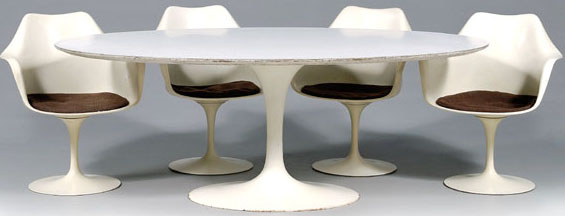Eero Saarinen (1910-1961)
Finnish architect Eero Saarinen embraced new materials and technology, and nowhere is that more apparent than in his TWA Terminal Building & his Tulip Series chairs and tables. Fifty plus years after their introduction, Eero Saarinen’s organic furniture designs still look futuristic, and like most classic designs, are at home in a variety of applications.
Eero Saarinen Brief Biography
Saarinen was born in 1910 on his father’s birthday. Eero was the son of a Finnish architect, Eliel, who would later be the first president of the Cranbrook Academy of Art in Bloomfield Hills (near Detroit, Michigan). The family emigrated to the U.S. in 1923. Eliel worked at Cranbrook, and Eero essentially grew up there., where he formed a relationship with future design giant Florence Schust (Knoll).
Eero Saarinen & Ray and Charles Eames
Eero studied at the Yale school of architecture where he received his degree in 1934. After completing his education, he took off for an extended tour of Europe that included a year in Finland. By the early 40s, he was teaching at Cranbrook Academy. Here he met Ray and Charles Eames. Together they created a series of prototype chairs designed for mass production, but were never manufactured because the necessary industrial processes did not exist at that time. The Eames & Saarinen prototypes for the Single Form Plywood Seats won an award at the 1940 Organic Design in Home Furnishings Exhibition that was held at The Museum of Modern Art in New York City.
Saarinen, Swanson, and Associates
With the success of his plywood seating, Saarinen’s career was off and running, and he opened his design office, Saarinen, Swanson and Associates in Bloomfield Hills, Michigan. in which he worked until his early death in 1961. His best known architectural work is probably his dramatic and futuristic design for the Trans World Airlines Terminal at Kennedy Airport (New York City) in 1962. The free-flowing curves of this sculptural concrete building suggest flight, and served as inspiration for the famous Sidney Opera House in Australia. The TWA terminal is on the National Register of Historic Places.
Saarinen’s Tulip Series
Saarinen’s taste for organic forms is as evident in his furniture as his buildings. His best known furniture, the Tulip Series, featured nature inspired forms executed through cutting edge technology and material applications. The Tulip Chair, developed in the 1956, features a revolutionary one-piece sculptural design that looked like seating one might find on a space ship.

Erro Saarinen for Knoll International, a Tulip table and four chairs, circa 1957
p4A item D9801724
Saarinen’s Tulip Chair Technology
Saarinen’s intent was to create a chair in one piece only, with no added fittings or visible hardware. His original idea called for a chair that was made completely of molded plastic, but the technology to do so was unavailable at that time. Instead, the fiberglass shell sat atop a plastic clad aluminum base. The Tulip Chair was one of the first to sit on a single pedestal base. Variations of the Tulip Chair include an arm shell model (#150) and an armless version (#151). The chairs are also available with upholstered seat cushions. The Tulip Chair was originally produced by Saarinen for Knoll, the company that still manufacturers it today.
Tulip Tables by Saarinen
Saarinen designed a line of tables to match his chairs, and these are available a variety of sizes, versions, and finishes. All have the signature base, but the tops are available in wood, white laminate, and marble. The tables come in side table and dining versions. Vintage versions with marble tops are the most valuable of the table models.
Both Tulip Chairs and Tulip Tables are popular with lovers of classic modern designs, and early examples of the tables and chairs in almost all variations are valuable and eagerly sought by collectors.
Reference: Hoban, Sally; Collecting Modern Design, c2001, Miller’s.
Reference note by p4A contributing editor Susan Cramer.
